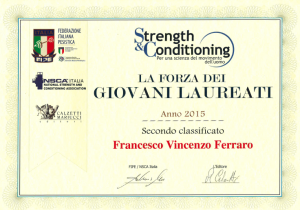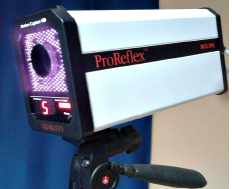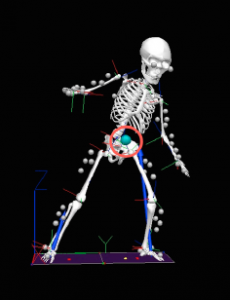
Last Friday a postman knocked at my parent’s house in Italy.
He carried a parchment, from The National Strength and Condition Association.
On it is written that my Master Degree Thesis won “The strength of young graduates contest” as second best Italian research in its field.
The study of 2015, is titled: “THE BIOMECHANICS EVALUATION IN STUDYING THE MOTION – COGNITION RELATIONSHIP” and can be summarised as follow:
 using a system of 8 QTM cameras and a force plate, I measured the effect of different tasks upon the static balance in 20 young volunteers.
using a system of 8 QTM cameras and a force plate, I measured the effect of different tasks upon the static balance in 20 young volunteers.
To do so, I asked them to perform four tasks in a randomised order, while I was recording their centre of pressure (with force plate) and centre of mass (with 3D motion capture system).
Tasks were:
- Open Eyes (OE). The participants were instructed to hold a steady position, standing up with their feet together, for 30s.

- Closed Eyes (CE). Same position as OE, but participants were instructed to keep their eyes closed for 30s.
- Cognitive Dual Task (COGN-DT). Holding the same steady position, I asked them to countdown aloud, backwards in threes from a number that I randomly chose.
- Motor Dual Task (MOT-DT). Same position, but for this task volunteers were instructed to move their fingers (of the right hand) and touch their thumb alternately, for 30s.
What the result told us was that the COGN-DT was causing more perturbation, followed by the CE task.
 Special thanks go to the people who helped me at the MotionLab in Naples (Giuseppe Sorrentino, Laura Mandolesi and Pasquale Varriale), and to my current supervisors (Alison McConnell, Tom Wainwright and James Gavin) who believed in me by giving me the opportunity to be here today.
Special thanks go to the people who helped me at the MotionLab in Naples (Giuseppe Sorrentino, Laura Mandolesi and Pasquale Varriale), and to my current supervisors (Alison McConnell, Tom Wainwright and James Gavin) who believed in me by giving me the opportunity to be here today.
Looking forward, with hope to collect more milestones.
Thanks.











 3C Event: Research Culture, Community & Cookies – Tuesday 13 January 10-11am
3C Event: Research Culture, Community & Cookies – Tuesday 13 January 10-11am Dr. Chloe Casey on Sky News
Dr. Chloe Casey on Sky News Final Bournemouth University publication of 2025
Final Bournemouth University publication of 2025 On Christmas Day in the Morning…
On Christmas Day in the Morning… New Nepal scoping review on maternal & neonatal health
New Nepal scoping review on maternal & neonatal health ECR Funding Open Call: Research Culture & Community Grant – Application Deadline Friday 12 December
ECR Funding Open Call: Research Culture & Community Grant – Application Deadline Friday 12 December MSCA Postdoctoral Fellowships 2025 Call
MSCA Postdoctoral Fellowships 2025 Call ERC Advanced Grant 2025 Webinar
ERC Advanced Grant 2025 Webinar Horizon Europe Work Programme 2025 Published
Horizon Europe Work Programme 2025 Published Update on UKRO services
Update on UKRO services European research project exploring use of ‘virtual twins’ to better manage metabolic associated fatty liver disease
European research project exploring use of ‘virtual twins’ to better manage metabolic associated fatty liver disease